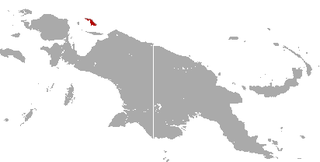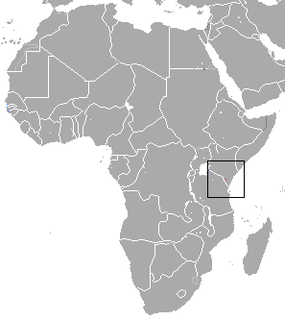
The New Zealand fernbird or simply fernbird is an insectivorous bird endemic to New Zealand. In the Māori language, it is named kōtātā or mātātā.
The fiery spiny mouse is a species of rodent in the family Muridae found in Kenya and Tanzania. Its natural habitats are dry savanna and rocky areas. It may be found as a commensal in human habitations.
Wilson's spiny mouse is a species of rodent in the family Muridae. It is found in Ethiopia, Kenya, Somalia, South Sudan, Tanzania, and Uganda. Its natural habitats are dry savanna, subtropical or tropical dry shrubland, and rocky areas.
The Isarog striped shrew-rat or Mount Isarog striped rat is a species of rodent in the family Muridae found only in the Philippines.
Fox's shaggy rat is a species of rodent in the family Muridae. It is found only in Nigeria. Its natural habitats are moist savanna, subtropical or tropical seasonally wet or flooded lowland grassland, swampland, and plantations. It is threatened by habitat loss.
The Angolan marsh rat is a species of rodent in the family Muridae. It is found in Angola, Botswana, Namibia, and Zambia. Its natural habitats are subtropical or tropical seasonally wet or flooded lowland grassland and swamps. It is threatened by habitat loss.
Nesoryzomys fernandinae, also known as the Fernandina nesoryzomys, Fernandina rice rat, or Fernandina Galápagos mouse, is a species of rodent in the genus Nesoryzomys of family Cricetidae. It is found only on Fernandina in the Galápagos Islands, which it shares with N. indefessus narboroughi. Its natural habitat is subtropical or tropical dry shrubland. The conservation status of this endemic species continues to be investigated.
Hopkins's groove-toothed swamp rat is a species of rodent in the family Muridae. It is found in Kenya, Rwanda, Uganda, possibly Burundi, and possibly Tanzania. Its natural habitat is swamps. It is threatened by habitat loss.
The Cameroon soft-furred mouse or Cameroon praomys is a species of rodent in the family Muridae. It is found in Cameroon and Equatorial Guinea. Its natural habitat is subtropical or tropical moist montane forests. It is threatened by habitat loss.

The Hawaiʻi ʻamakihi, also known as the common ʻamakihi, is a species of Hawaiian honeycreeper.

The wood sprite gracile opossum is a mammal. It is a species of opossum in the family Didelphidae. It is found in Colombia and Venezuela. Its natural habitat is subtropical or tropical moist lowland forests. It is threatened by habitat loss.

The Irrawaddy squirrel or hoary-bellied Himalayan squirrel is a species of rodent in the family Sciuridae. It is native to Bangladesh, China, India, Myanmar, and Nepal.

Epixerus ebii, also known as Ebian's palm squirrel, Temminck's giant squirrel, or the western palm squirrel, is a species of rodent in the family Sciuridae. It is the only species in the genus Epixerus, although eastern populations were previously regarded as a separate species, E. wilsoni. It is found in West and Central Africa. Its natural habitat is subtropical or tropical moist lowland forests. It is threatened by habitat loss.
Swynnerton's bush squirrel or Svynnerton's bush squirrel, Paraxerus vexillarius, is a species of rodent in the family Sciuridae endemic to Tanzania. Its natural habitat is subtropical or tropical moist montane forests. It is threatened by habitat loss.

The blue-eyed spotted cuscus or Biak spotted cuscus is a species of marsupial in the family Phalangeridae. It is endemic to the islands of Biak and Supiori in the Cenderawasih Bay in West Papua of Indonesia. Only scientifically described in 2004, it appears to be very rare, likely due to hunting and habitat loss, and has consequently been rated as critically endangered by the IUCN. Recent surveys have failed to find any wild individuals. Unlike all other members of the genus Spilocuscus, this relatively small species has distinct pale blue eyes.
Wilson's blind snake is a species of snake in the family Leptotyphlopidae. The species is native to Yemen.

The Taita shrew is an extant species of white-toothed shrew from two localities in the Taita Hills mountain range in the Taita-Taveta District of southwestern Kenya. Given the continuing decline in the quality of this habitat, and the limitations in its range, the IUCN recognises the shrew as an endangered species.
The Mount Augustus spiny-tailed gecko, also known commonly as the Mount Augustus striped gecko and Wilson's spiny-tailed gecko, is a species of lizard in the family Diplodactylidae. The species is endemic to Australia.
Eumops wilsoni is a species of bat native to Ecuador and Peru. The bat has a distinct karyotype, sequence of the mitochondrial cytochrome-b gene, and other distinct genetic markers that distinguish it from closely related bats such as Eumops glaucinus and Eumops ferox. However, there are no morphological distinctions from those related species and thus there is uncertainty of its geographic distribution and population status, leading to its classification as "data deficient". Local threats to the bat's dry forest habitat further impede efforts to study the bats. Transition to farmland and urbanization threatens the dry forest habitat of the bat in the Andes. As an endemic species, the bat may be threatened by this habitat loss.
Panaspis wilsoni, also known commonly as Wilson's dwarf skink and Wilson's snake-eyed skink is a species of lidless skink, a lizard in the family Scincidae. The species is endemic to Sudan.





